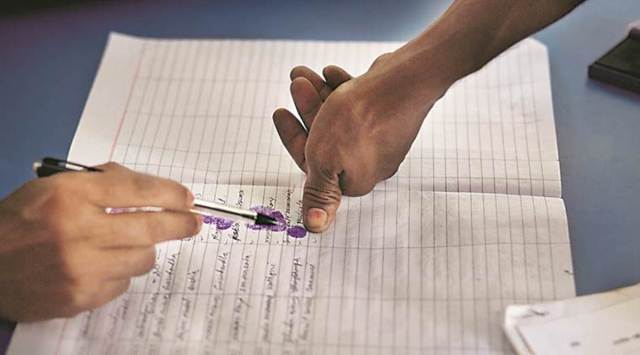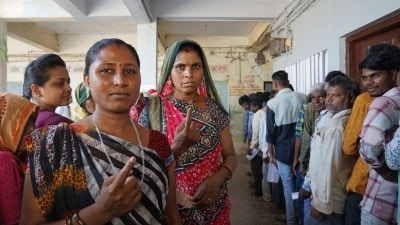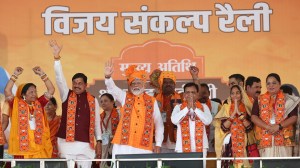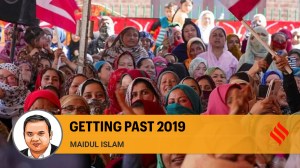- India
- International
MHA’s Clause 6 panel sets 1951 as year to determine Assamese
As protests against the Citizenship (Amendment) Act spiralled across Assam since December last year, the Sarbananda Sonowal-led state government promised a speedy implementation of Clause 6 as an antidote to the agitation and a measure to protect the interests of the “indigenous” people of Assam.
 The NRC process has hit a stonewall since then with the NRC office yet to issue rejection orders to the 19 lakh excluded persons. (File)
The NRC process has hit a stonewall since then with the NRC office yet to issue rejection orders to the 19 lakh excluded persons. (File)A high-level committee on implementation of Clause 6 of the Assam Accord constituted by the Ministry of Home Affairs has said that ‘Assamese people’ should be determined by taking 1951 as a cut-off year. The report of the 14-member committee, submitted to the state government in February this year, was released to the press by four of its members on Tuesday.
Three of these four members — Samujjal Bhattacharya, Dipankar Nath and Lurinjyoti Gogoi — are senior All Assam Students’ Union (AASU) functionaries. The fourth member, Nilay Dutta, is a renowned advocate and Advocate General of Arunachal Pradesh.
The report said that the definition of ‘Assamese People’ for the purpose of implementation of Clause 6 of the Assam Accord should include Indigenous Tribals as well as other Indigenous Communities of Assam, all other citizens of India residing in the territory of Assam on or before 01.01.1951 and Indigenous Assamese — and their descendants.
In a statement issued Tuesday evening, Chief Minister Sarbananda Sonowal described the disclosure of the report as “very unfortunate”. He said the government was committed to implement each and every clause of the Assam Accord. He said no government in the past had formed a committee to implement Clause 6.
“Simultaneously, the Central government is also taking steps in this regard. Therefore, without giving a definite timeframe, disclosing the report of the committee is very unfortunate,” Sonowal said.

“The State government is always devoted to safeguard the constitutional rights of the indigenous people through implementation of Clause 6 of the Accord. In no uncertain terms, the State Government desires to inform the people that no compromise will be made in this regard,” he said.
The 1985 Assam Accord set a cut-off of midnight of March 24, 1971, for the detection of “illegal foreigners” in Assam — the National Register of Citizens (NRC) preparation in Assam uses the same cut-off — but the Accord did not define who were eligible for the safeguards.
The Clause 6 of the Accord says “Constitutional, legislative and administrative safeguards, as may be appropriate, shall
be provided to protect, preserve and promote the cultural, social, linguistic identity and heritage of the Assamese people”.
The committee chaired by Justice (retd) Biplab Kumar Sarma was constituted to define ‘Assamese People’ and institute safeguards for them.
As protests against the Citizenship (Amendment) Act spiralled across Assam since December last year, the Sarbananda Sonowal-led state government promised a speedy implementation of Clause 6 as an antidote to the agitation and a measure to protect the interests of the “indigenous” people of Assam.
The report recommended numerous reservations for “Assamese people”, like 80 to 100% of Assam’s seats in Parliament; and the same proportion in Assembly and local bodies (inclusive of pre-existing reservations). It recommended reservation of 80 to 100% of Group C and D level posts in all government and private sector jobs in Assam “Assamese people” while 80%-100% of jobs under Government of Assam and State Government undertakings and 70%-100% of vacancies in private partnerships including PPP model in Assam should be reserved for ‘Assamese people’.
The recommendations also include the implementation of an Inner Line Permit regime in the state. The ILP is system in which a special permit is required by people from other regions of India to visit the state. It also recommended the making of “an Upper House (Legislative Council of Assam)” whose seats will be reserved for the ‘Assamese people’.
The report also stressed on land rights and said “land rights be confined” to the ‘Assamese people’ by “putting restrictions on transferring the same by any means to other persons other than ‘Assamese people’”.
Since the submission of the report, the state government has been silent on it. The AASU leadership questioned the delay in any announcement regarding the report and said they are releasing it to the public.
“The government is keeping completely silent over the report we have submitted. People have a right to know what we submitted. Moreover, in a democratic society people should have to right to read it and point out if any rectification or omissions are there,” Lurinjyoti Gogoi, general secretary, AASU, told The Indian Express.
Gogoi said, “It’s a public document and we have released it after five months. Why is the government silent — we want to ask them. There has been not even one step towards implementation of our recommendation till now although they had promised that it will be implemented without even altering any punctuation.”
Assamese socio-political groups like the AASU have stressed repeatedly that Clause 6 was required to safeguard the interests of the indigenous people of Assam since the state has accepted migrants from 1951 to 1971 as per the Accord.
According to the recommendations, people who migrated between 1951 and 1971, including large sections of post-Partition refugees, would be Indian citizens under the Assam Accord and the NRC, but they would not be eligible for safeguards meant for “Assamese people” under Clause 6 of the Accord — and this is a problem many are highlighting.
Azizur Rahman, adviser to All-Assam Minority Students’ Union, told The Indian Express: “How will you prove that a person has been in Assam prior to 1951? Till date, there is no mechanism to do so. Will it be decided arbitrarily? The 1951 NRC is not available in several parts of the state and the current NRC being made uses 1971 as a cut-off.”
May 07: Latest News
- 01
- 02
- 03
- 04
- 05





































